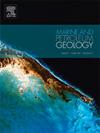致密气藏充注动力学模型——以四川盆地须家河组为例
IF 3.6
2区 地球科学
Q1 GEOSCIENCES, MULTIDISCIPLINARY
引用次数: 0
摘要
致密气作为一种重要的非常规天然气资源,其赋存对天然气的成藏具有重要意义。然而,致密气充注过程复杂多样。以往的研究主要集中在单个充注参数上,缺乏多因素耦合对致密气充注过程控制的研究。为此,本文以四川盆地上三叠统须家河组致密砂岩为例,通过核磁共振(NMR)耦合驱替物理模拟,结合物性分析、扫描电镜(SEM)、x射线衍射(XRD)、高压压汞(HPMI)等实验,阐明了致密砂岩的研究意义。研究结果表明:①根据孔隙结构的差异,须家河组致密储层可划分为4种类型。从ⅰ型到ⅳ型储层,绿泥石包覆层和溶蚀作用逐渐减弱,孔隙特征(核磁共振T2谱)由以大孔为主的双峰分布向以微孔为主的单峰分布转变。(2)致密气充注过程分为三个阶段:低压快速充注阶段(A)、中高压慢充注阶段(B)和后期非连续慢充注阶段(C)。(3)致密气充注过程受充注压力、孔隙结构和水膜等因素的综合控制。较高的充注压力对差储层含气量影响显著。在相同充注压力下,气体饱和度随孔隙尺寸的减小而减小。随着充注压力的增大,水膜的影响减小。(4)通过多因素分析,建立了考虑储层类型和压力的致密气饱和度评价模型,能够预测不同类型致密储层的致密气充注过程和含气饱和度。该研究不仅有助于认识致密气的成藏过程,也为致密气甜点的准确预测提供了理论依据。本文章由计算机程序翻译,如有差异,请以英文原文为准。
Dynamic model for charging tight gas reservoirs: A case study from the Xujiahe Formation in the Sichuan Basin, China
As an important unconventional natural gas resource, the occurrence of tight gas is of great significance for the accumulation of natural gas. However, the charging process of tight gas is complex and diverse. Although previous studies have mainly focused on individual charging parameters, there is a lack of research on the coupling of multiple factors on the control of the charging process of tight gas. Consequently, this paper uses an example from the tight sandstones of the Upper Triassic Xujiahe Formation, Sichuan Basin, China, to elucidate insights by employing physical charging simulation of nuclear magnetic resonance (NMR) coupling displacement combined with physical property analyses, scanning electron microscopy (SEM), X-ray diffraction (XRD), and high-pressure mercury injection (HPMI) experiments. The principal findings are: (1) The tight reservoirs of the Xujiahe Formation can be classified into four types based on the differences in pore structure. From Type I to IV reservoirs, chlorite coatings and dissolution progressively weaken, with pore characteristics (as shown by NMR T2 spectra) transitioning from a bimodal distribution dominated by macropores to a unimodal distribution characterized by micropores. (2) The charging process of tight gas is divided into three stages: low-pressure rapid charging stage (A), medium-high pressure slow charging stage (B), and late non-continuous slow charging stage (C). Type I reservoirs are mainly charged in stage A, Types II and III reservoirs in stage B, and Type IV reservoirs in stage C. (3) The charging process of tight gas is controlled by a combination of charging pressure, pore structure, and water film. Higher charging pressure has a significant impact on the gas content of poor reservoirs. Under the same charging pressure, the gas saturation decreases with the decrease in of pore size. As the charging pressure increases, the influence of the water film diminishes. (4) Through multi-factor analysis, a tight gas saturation evaluation model is established that considers reservoir types and pressure and can predict the tight gas charging process and gas saturation in different types of tight reservoirs. This research not only aids in understanding the accumulation process of tight gas but also provides a theoretical foundation for the accurate prediction of tight gas sweet spots.
求助全文
通过发布文献求助,成功后即可免费获取论文全文。
去求助
来源期刊

Marine and Petroleum Geology
地学-地球科学综合
CiteScore
8.80
自引率
14.30%
发文量
475
审稿时长
63 days
期刊介绍:
Marine and Petroleum Geology is the pre-eminent international forum for the exchange of multidisciplinary concepts, interpretations and techniques for all concerned with marine and petroleum geology in industry, government and academia. Rapid bimonthly publication allows early communications of papers or short communications to the geoscience community.
Marine and Petroleum Geology is essential reading for geologists, geophysicists and explorationists in industry, government and academia working in the following areas: marine geology; basin analysis and evaluation; organic geochemistry; reserve/resource estimation; seismic stratigraphy; thermal models of basic evolution; sedimentary geology; continental margins; geophysical interpretation; structural geology/tectonics; formation evaluation techniques; well logging.
 求助内容:
求助内容: 应助结果提醒方式:
应助结果提醒方式:


